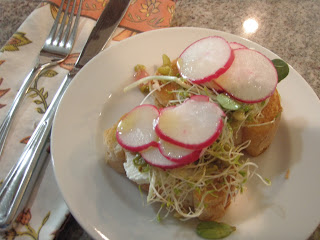“Such a dish as powdered wife I never heard of,” wrote Capt.
John Smith in 1624 in his Generall
Historie of Virginia, New-England, and the Summer Isles. (By powdered he meant salted.) He told the
story of digging up graves and eating the dead as well as a man who “did kill
his wife, powdered her, and had eaten part of her before it was known, for
which he was executed, as he well deserved; now whether she was better roasted,
boiled or carbonado’d (barbequed), I know not.”
We recently visited Jamestown learning of the early history
of English settlement in America and learning of the winter of 1609-1610 being
known as the starving time. In the same
week we visited, there were reports on TV and in the paper of archaeologists
excavating a trash pit at the Jamestown site having found the first physical
evidence of cannibalism among the desperate population, corroborating written
accounts left behind by witnesses.
We went to Virginia to enjoy spring again with Historic
Garden Week in Virginia, its 80th year of sharing its historic homes
and gardens all across the state with visitors. The Garden Club of Virginia invited visitors
to more than 200 of Virginia’s private homes and gardens this year, “America’s
Largest Open House.” We visited Eyre Hall on the Eastern Shore, 1758, with its
200 year old formal garden. The 13th
generation living there was sharing their home for the 65th year
with visitors. We visited Tuckahoe, the
childhood home of my husband’s hero, Thomas Jefferson. The family there has owned the home since the
1930’s and it was opened for the first Garden Week in 1929. We stayed in Historic Williamsburg in a
colonial inn and had several of our meals in the taverns. We were disappointed in the fare with one
exception, a green salad with spring peas, said to be inspired by Thomas
Jefferson. Most of Virginia is inspired
by Thomas Jefferson.
We did visit Old Donation Episcopal Church in Virginia Beach,
1637, the second oldest Anglican congregation in America. We hoped to see Bob Randall, past Vicar of
St. Mary’s of Andalusia. However, he was in England on sabbatical.
I did think the Jefferson inspired salad was worth repeating
when I got home. We have fresh English
peas in the garden right now and you should be able to find them in the grocery
as well, but frozen peas can be used.
Spring Salad adapted from Christiana Campbell’s Tavern,
Williamsburg, Virginia
Serves 2
2 cups of lettuce (various kinds will do)
1 cup of peas (frozen or fresh); of course fresh is better
Ranch Dressing
1 cup of mayonnaise
½ cup sour cream
½ teaspoon dried chives
½ teaspoon dried parsley
½ teaspoon dried dill weed
¼ teaspoon garlic powder
¼ teaspoon onion powder
1/8 teaspoon salt
1/8 teaspoon ground black pepper
In a large bowl, whisk together the mayonnaise, sour cream,
chives, parsley, dill, garlic powder, onion powder, salt and pepper. Cover and
refrigerate for 30 minutes before serving.
To assemble: place a cup of lettuce on two plates. Boil the
peas in boiling water for only 1 minute. Dress the peas with enough Ranch
dressing to cover. Some will be left for another salad. Garnish with green
onions, radishes, and boiled eggs.
Your own Ranch dressing will be better than the package or
bottled.
The following recipe is a favorite of ours using edible
podded peas. It, however, is not an old
Virginia recipe. “Most 18th
century peas were consumed as shell peas, but the sugar, or edible podded, pea
(P. sativum var. saccharatum) was also known.
This pea was often called the sickle pea, for the crooked, sickle-shaped
pods.” This I learned from a great new
garden book I purchased in Williamsburg, Vegetable
Gardening, The Colonial Williamsburg Way by Wesley Greene. I had thought
edible podded peas to be a more modern ‘invention.’
I used this recipe in the May 16, 2009 issue of the
Andalusia Star News. I do it several times in the spring when the sugar snap
peas are at their best. It always gets rave reviews for it freshness and I have
used it often at church picnics or
church suppers.
Rice Salad with Sugar Snap Peas, Mint and Lime
6 servings
Bring to a boil in a small saucepan 2 cups water and 1
teaspoon salt. Stir in 1 ½ cups rice, reduce heat to low, cover 15 minutes. Let
stand 5 minutes, fluff with fork and cool completely in a large bowl. Cook in
boiling water, 2 cups sugar snap peas, for one minute. Drain and rinse under
cold water.
Mix into rice:
½ cup fresh mint leaves
½ cup chopped green onions
3 tablespoons olive oil
2 tablespoons lime juice
2 tablespoons julienned peeled fresh ginger
1 teaspoon sugar
Cooked sugar snap peas
Salt and pepper to taste
Serve cold or at room temperature.







